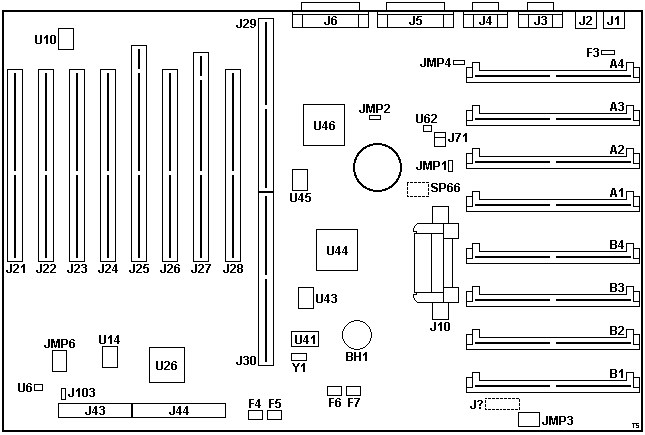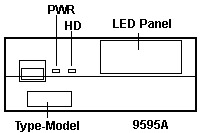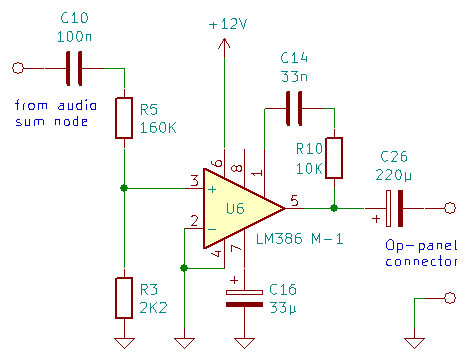|
85, 95, and 3511 Common Devices (Installing drives, memory etc.)
Opening and closing the case
Operator Panel Information
95A Planar
System Firmware
95A Ports
95A Operator Panel
Compatible Complexes
JMP6 Remote Maintenance Processor
J103 Remote Power-ON Request
LogicLock
Power-On Features (Wake-On-Ring, Kickstart, Wake-Up)
Schematic of Audio Stage
Hacking a 95A Planar into a 8595 Case
ADF Sections (PE4FE.ADF)
95A Planar FRU P/N 92F2623, P/N 06H2848, "THE DELIVERY BOYS"
![Top [P]](/other/img/photo.gif)
![Bottom [P]](/other/img/photo.gif)
This is the most advanced PURE
Micro Channel planar. There are none higher.

U44 92F2384? or 61G2800 drives the
ExpressPrint parallel port (A).
U46
10G4672 I/O controller implements
the second parallel port (B) among many other things.
U62 Pin 6 of the ST93C46A EEPROM chip
is not grounded, setting it to the 64 word x 16 bits mode. This setting is
reflected by the BIOS code.
JMP6
Remote Maintenance Service Connector
can be used to add a reset button.
The 9595 planar is a single-side load PCB, meaning there are no components
whatsoever on the bottom side, not even passive SMDs.
System Firmware (POST & BIOS)
Firmware stored on the Processor Complex.
95A Ports

COM ports are 345K capable
EP is an ExpressPrint parallel port
LPT is a standard parallel port
95A Operator Panel

More information about the operator panel can be found
HERE.
Compatible Complexes
Running any other complex but a Type 4 (N, P,
Q, or Y) on the 2S2P planar will result in a 172 error code. And that's all you
will get. The planar is fine, it just won't work. Replace the complex with a
Type 4 and it will come up fine...
Tom says:
The T1-T3 POST/BIOS lacks support for the newer planar. Some of
the planar POS registers are organized differently and the older BIOS code will
not know how to use them properly. Even if you patch the refdisk binaries and
add the necessary ADFs and other files, it won't change the fact that the
ROM-resident POST code is outdated/incompatible. The T4 BIOS works correctly
with both planars, because it checks the planar ID where necessary and then
does different things based on the returned value. Additionally, the T4 NVRAM
rolling bit test has an extra delay in the test loop, so the Dallas DS1585S
NVRAM chip probably has slightly different timing requirements. That would
explain the 172 POST error.
JMP6 Remote Maintenance Processor
If you do NOT have a ServerGuard
adapter installed, this header MUST have a jumper on the two pins on the right.
Otherwise your system will NOT power up. Also look at
JMP6. and also the
power stuff.
J103 Remote Power-ON Request
The J103 header can be used to turn the system on (and off) from some
external source. This can be achieved by connecting pin 2 to ground (either of
the remaining pins).
| Pin | Description |
|---|
| 1 | Ground |
| 2 | -Remote Power-ON Request |
| 3 | Ground |
Pin 2 is directly connected to pin 29 of the nearby Op Panel connector (J43).
LogicLock
This interesting bit of
security hardware is a
mechanical switch that detects if someone has attempted to open the case
without using the key to unlock it. First, you need to set the administrator's
password. Note: If you forget the
administrator's password, you will have a planar that will not work. There has
been some attempts to replace the DS1285, but that's not the complete fix. A
VPD error keeps occurring. It seems the password is stored in two locations?
Next you need to set the unauthorized access monitor to "Enabled"
under Set Configuration. Note: I do not
advise you to set the
unauthorized
access monitor to anything BUT disabled.
I'm still trying to understand WHAT the LL will do after someone
attempts to pry open your 95A system. It will definitely log the attempt. But
what does it do after?
Unattended Start Mode
Power-On password must be set first. The use of the unattended start mode
(Also called "Network Server Mode") on PS/2 systems will disable the mouse
port. This is normal system operation and should not be considered a defect.
Disabling the mouse port is required to maintain security of the system when
using unattended start mode. IBM's explanation
HERE (dead).
Power On Features
The power supply in Server 95 has a power-on/standby mode. In the standby
mode, the system can be power-on by either of three methods: the power switch,
a wake-up alarm from the real-time clock, or a start-up signal from serial port
A (kickstart feature). The wake-up alarm and kickstart feature can be disabled
by software - see Extended Control Register B (4Bh).
Wake-On-Time or Wake-up alarm: system powers on when the time and day
matches the alarm bytes.
Wake-On-Ring or Kickstart: system powers on
when serial port A detects incoming call or data.
The system can then be powered-off (standby mode) by the power switch or by
setting the return-to-standby bit to 1 - see Extended Control Register A
(4Ah).
Note: From the standby mode, the power switch must
be pressed twice to turn the power off. When first pressed, the switch places
the power supply in the power-on mode. Wait about 5 seconds, then press the
switch again to place the system in the standby mode.
95A Audio Stage Schematic

LM386 Pinout:

Complete datasheet HERE.
Peter wrote (edited):
Given the signal source is 5 Vpp @ 162 KΩ load, the voltage
at pin 3 is currently 0.068 Vpp. At 26 dB amplification the output is 1.35 V
for the normal linear amplification outside the frequency range when the bass
boost is effective.
C16 bypasses DC ripple to GND, R10/C14 act as bass boost (low pass filter)
to turn up the amp gain at lower frequencies for compensating poor speaker bass
response. Impedance of the Op Panel speaker is 8 Ω.
To get a better output the R5 resistor could -probably- been bridged by e.g.
a 220 KΩ resistor, which *should* result in a higher over all gain, but I
don't know what's the output impedance of the audio sum node.
It might be better to directly set the amp gain control pin 8 to pin 1 with
a 10 µF / 10 KΩ RC combo. That should result in a total amp gain of
about 30 (20 = 26 dB if 1 & 8 are open, 200 = 46 dB if only a 10 µF
is used). Or altering the voltage divider R5 / R3 might also help.
Y2K Level 1 Compliant
After arduous testing in the Fortress of Solitude, I have determined THE
requirement for Level 1 compliance, and that is the Dallas DS1585S Serialized
RTC. This chip has the required routine to accept the rollover all by itself.
Other MBs that use the older Dallas DS1285 are Level 2 compliant. (all 90s, all
M class 95s, possibly X class 85s).
Hacking an 8595 Case
Yes, you CAN put a 95A planar into a 95 case. Basically, you have to extend
the port opening downward until it's 9 1/16" long. The metal frame port opening
must be extended downward so it's 9 1/16" long.
First, pull the complex, adapters, power supply, drives, and
planar. Then remove the rear bezel by removing the 5 hex head screws. The rear
bezel will pivot upwards like the front bezel. Now you can hacksaw the frame
opening downwards. I used a coping saw to cut across the bottom of the
opening.
Do the same to the rear bezel. Take a file and smooth up the cut
edges (or you WILL pay for it later!). The metal frame has a very thin web left
next to the opening for the power supply. It bent on me when I tried to bend up
a lip for the longer EMC spring on the planar. Just say the hell with it and
cut both sides of the port opening straight down.
The real difficult part is to put the rear bezel back on. It SEEMS
easy enough. You start by putting the "hinges" on the top of the pivots at the
back of the case. Now try the delicate ballet of exactly lining the rear bezel
up with the lips on the metal frame It took me a good 20 minutes. Note the
bottom of the expansion slots has a lip that the rear bezel MUST fit onto.
I now believe that cutting the frame while the rear bezel is still
screwed on will be the easiest way. Still clean the fresh edges up with a file.
Use compressed air to blow any metal fragments out.
Put in the new planar. Match up the spring clip with the lip on
the frame. Push forward and pivot the planar downward onto the lip. Make sure
the screw holes match up - the planar can be too far up or down on the lip. To
adjust the height, pull the planar up and to the rear. When it comes loose,
move it the correct direction then reseat it.
ADF Sections for 95A Planar PE4FEh "Built In Features"
Num Lock
Determines how the Num Lock key will be set when the operating
system is started. Please note that your operating system environment might
change the setting of the Num Lock key. The normal setting of this feature
is <Off>.
<"Off">, On"
Display F1 Prompt
During startup, your system normally displays a prompt that tells
you to press F1 for access to the system programs. If you wish to suppress this
prompt, change the setting to <No>.
<"Yes">, No
Hands-off Configuration
Normally, when you add or remove adapters, devices, or memory, you
provide input to reconfigure the system. If you change this setting to <Enable>,
the system will attempt a hands-off configuration when hardware is added or removed.
No user input will be required unless the default values cannot be used.
<"Disable">,
Enable
First Serial Port (A) (Top Serial Port)
Serial port A can be assigned as Serial 1 through Serial 16, or
disabled. Standard usage of interrupt levels is IRQ 4 for serial 1 and IRQ 3 for
any other serial level.
<"SERIAL 1,
IRQ 4">, SERIAL 2, IRQ 3, SERIAL 3, IRQ 3, SERIAL 4, IRQ 3, SERIAL
5, IRQ 3, SERIAL 6, IRQ 3, SERIAL 7, IRQ 3, SERIAL 8, IRQ 3, SERIAL 9,
IRQ 3, SERIAL 10, IRQ 3, SERIAL 11, IRQ 3, SERIAL 12, IRQ 3, SERIAL 13,
IRQ 3, SERIAL 14, IRQ 3, SERIAL 15, IRQ 3, SERIAL 16, IRQ 3
"SERIAL 4, IRQ 4, CUSTOM, SERIAL 5,
IRQ 4, CUSTOM, SERIAL 6, IRQ 4, CUSTOM, SERIAL 7, IRQ 4, CUSTOM, SERIAL
8, IRQ 4, CUSTOM, SERIAL 9, IRQ 4, CUSTOM, SERIAL 10, IRQ 4, CUSTOM, SERIAL
11, IRQ 4, CUSTOM, SERIAL 12, IRQ 4, CUSTOM, SERIAL 13, IRQ 4, CUSTOM,
SERIAL 14, IRQ 4, CUSTOM, SERIAL 15, IRQ 4, CUSTOM, SERIAL 16, IRQ 4, CUSTOM,
Disabled
Second Serial Port (B) (Bottom Serial Port)
Serial port B can be assigned as Serial 1 through 16, or disabled.
Standard usage of interrupt levels is IRQ 4 for serial 1 and IRQ 3 for any other
serial level.
<SERIAL 2, IRQ 3>,
SERIAL 3, IRQ 3, SERIAL 4, IRQ 3, SERIAL 5, IRQ 3, SERIAL 6, IRQ 3, SERIAL 7,
IRQ 3, SERIAL 8, IRQ 3, SERIAL 9, IRQ 3, SERIAL 10, IRQ 3, SERIAL 11, IRQ 3,
SERIAL 12, IRQ 3, SERIAL 13, IRQ 3, SERIAL 14, IRQ 3, SERIAL 15, IRQ 3,
SERIAL 16, IRQ 3
"SERIAL 4, IRQ 4, CUSTOM, SERIAL 5,
IRQ 4, CUSTOM, SERIAL 6, IRQ 4, CUSTOM, SERIAL 7, IRQ 4, CUSTOM, SERIAL
8, IRQ 4, CUSTOM, SERIAL 9, IRQ 4, CUSTOM, SERIAL 10, IRQ 4, CUSTOM, SERIAL
11, IRQ 4, CUSTOM, SERIAL 12, IRQ 4, CUSTOM, SERIAL 13, IRQ 4, CUSTOM,
SERIAL 14, IRQ 4, CUSTOM, SERIAL 15, IRQ 4, CUSTOM, SERIAL 16, IRQ 4, CUSTOM,
Disabled, SERIAL 1, IRQ 4
High Speed Parallel Port A (Bottom Parallel Port)
High speed parallel port A can be set as Parallel 1
- 4 or disabled.
<"Parallel 1" io 03bc-03bf
1278-127f int7>, Parallel 2 io 0378-037f int7, Parallel 3 io 0278-027f
int7, Parallel 4 io 1378-137f int7, Disabled
Ed. Parallel 2 is compatible with clone LPT 1.
Parallel Port A DMA Arbitration Level
High speed parallel port A can be set to any
one of the available DMA arbitration levels. If the level selected is shared
then other devices can be set at the same level. If the level selected is
dedicated then only this device can be set to that level. Select <Disabled>
to use the port in compatibility mode.
<"Shared level 7>,
6, 5, 4, 3, 1, 0 Dedicated "Level 7", 6, 5, 4, 3, 1, 0, Disabled
Ed. Windows cannot handle the serial DMA used,
so for such systems, disable DMA
Parallel Port A SCB I/O Address
High speed parallel port A can be set to any one of the available
SCB I/O addresses. Under normal circumstances this address range does not
need to be changed.
<"8100-8102">,
8900-8902, 9100-9102, 9500-9502, A100-A102, A900-A902, B100-B102, B900-B902,
C100-C102, C900-C902, D100-D102, D900-D902, E100-E102, E900-E902, F100-F102,
Disabled
Parallel Port B (Top Parallel Port)
Parallel port B can be set as Parallel 1 through 4 or the port can
be disabled.
<"Parallel 2" io 0378-037d
int7>, Parallel 3 io 0278-027d int7, Parallel 4 io 1378-137d int7,
Disabled, 1 io 03bch-03bfh 1278h-127d int7
Note: The order between LPT A and LPT B is
different.
Parallel Port B DMA Arbitration Level
Parallel port B can be set to any one of the available DMA
arbitration levels. Shared levels can be used by other devices. If the level
is dedicated then only this device can be set to that level. Select
<Disabled> to use the port in compatibility
mode.
<"Shared level 6>,
5, 4, 3, 1, 0, 7 Dedicated "Level 7", 6, 5, 4, 3, 1, 0, Disabled
Unauthorized-Access Monitor
If a privileged-access password (PAP) is set, the system monitors
its covers for evidence of tampering. If a PAP is set and this feature is
set to <Enabled>, the system stops if its
covers are tampered with. When the system stops, data in memory waiting
to be stored might be lost. If you do not want the system to stop when its
covers are tampered with, select <Disabled>
in the 'Change Configuration' window.
<"Enabled ">,
Disabled
Note: When you run the Automatic
Configuration program, this feature might be reset to
<Enabled>.
Ed. If you forget the PAP, you can't change
system configuration ever again. Very dangerous, leave
DISABLED!
ADPItem 1 Usable System-Board Memory
Type of Usable Memory on the system board, either parity or
error-correcting-code (ECC).
ADPItem 2 Bypass System Programs on Error
When the power-on self-test (POST) detects an error, POST normally
starts the system programs. If you want POST to start the operating system instead,
choose <Enable>. Warning: Setting this
to <Enable> could result in a partially
configured system when an adapter or device is added. A partially configured
system may cause some operating systems and applications to be inoperable.
ADPItem 3 Processor
Speed and type of processor CPU used in the system.
|